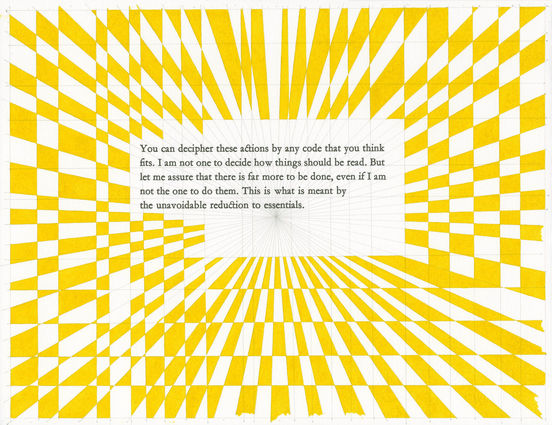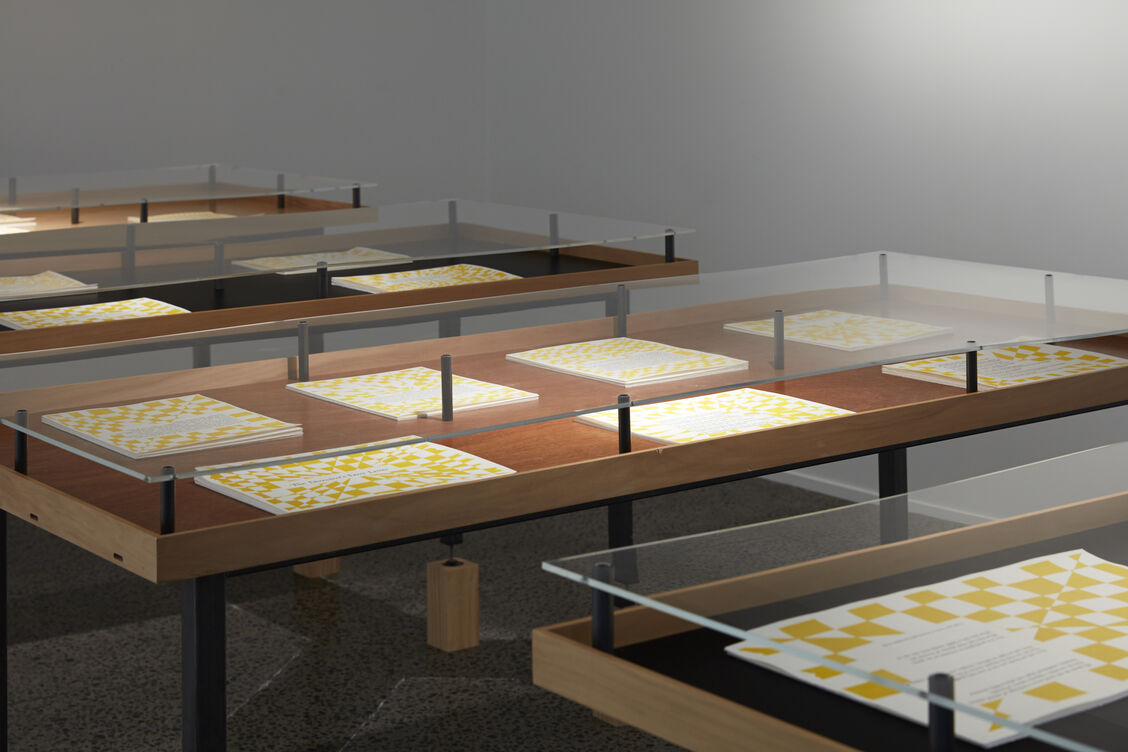-
Author
Gregory O’Brien -
Date
29 Sep 2017
Essay
Air Space and Wind Harp
Kathy Barry’s Drawings for Midway
The fibers of all things have their tension and are strained like the strings of an instrument.
— Henry David Thoreau
Door and trampoline
Commonly, each page of a book functions like a door, hinged to its spine and granting the reader access to the page that follows or, less often, the one before. The book’s cover is a double door containing all the other doors.
Kathy Barry’s works in Midway, however, proffer a different book-concept — one in which we experience each page or two-page-spread more as the surface of a trampoline, pulled taut to the edge of each folio or sheet, and upon which verbal and visual elements leap, play and come to a kind of animated life. As we are led onwards by John Yau’s unfolding poetry, the desire to turn the page is countered by the need to linger and contemplate Barry’s enigmatic, alluring entanglements of form and space.
Horizontal
In a book, each typeset line is an horizon, along which the eye travels before diving down and ducking back to begin again at the left-hand margin. Painterly convention usually allocates only one horizon per image, although the abstract compositions of Kathy Barry, with their many flat and tilted horizons, their overlapping and disorienting lines, their vanishing points and their detonated, fractured space, are a strident departure.
Exercise
As on a trampoline, everything drifts towards the centre—the middle point, the midway. Barry and Yau’s collaboration embodies such a meeting point or nexus: between an American poet and a New Zealand artist. In the shared, resonating, rebounding space of the open page, shards of colour gather around the edges of the typeset poetry. Barry’s pencil lines glide past the typeset lettering to suggest a deep space behind them. An inside. Far from offering a conventional flow or narrative, the book becomes an energetic routine, a field exercise, with all its crossings and recrossings. A renegotiation and rethinking of the page-space.
Breath
Each page of Midway might also be described as a unit of time, or an outward breath, followed by a pause—an intake of air—as the leaf is turned over, be it by the hand of the reader or a gust of wind. The book becomes a dynamic principle, both catalyst and vehicle. No matter what punctuation it contains, it is its own punctuation. Also, in the state of being read, it becomes a kinetic sculpture, moving beyond the flatness of its surfaces to occupy a three- or four-dimensional space. Left alone—open or closed—the book claims a shallower three-dimensional space, the front cover or open spread upraised on its mound of preceding and/or following pages.


Midway: a Collectif Génération collaboration by John Yau & Kathy Barry — Objectspace, 2017
Compression
Kathy Barry’s use of line and colour neither disturbs nor disguises the poetry. Neither does it necessarily elaborate upon or illustrate it. What the artist offers is an environment in which the words tremor with non-verbal possibility—a kind of parallelism very much in the spirit of Sonia Delaunay’s 1913 collaboration with Blaise Cendrars, The Prose of the Trans-Siberian and of Little Jehanne of Paris. Importantly, as critic Timothy Young has written, the Delaunay/Cendrars collaboration ‘championed the concurrent expression of art (mainly in the form of abstracted shapes and colours) with text’. In a similar spirit of high modernist aspiration, with a synchronous embrace of mystical and alchemical possibility, the offerings of Barry and Yau share the ‘continuous present’ of simultanéisme.
To the lyrical compression and refinement of Yau’s poetry, Barry’s drawings offer a counter movement—a visual de-compression: they push outwards to the four sides of the page. At times, the solid clump of typeset verse resembles a rock thrown into a pond — the surrounding coloured forms creating a lively, clamorous splash. In this process of compression and release, we witness another kind of kineticism.
Instrumental
Kathy Barry offers a setting for the poems—not so much in the sense of a physical backdrop, but in the musical sense. With their harmonies and their discordances, the drawings are a percussive, angular accompaniment—seemingly improvised, or composed according to principles or a process the viewer can only guess at.
Each copy of the book is its own unique moment. Each page. While Yau’s handprinted words are consistent across the edition, with each copy Barry’s elaborations begin again from scratch. In each case, the pencil takes a different tack. The machine starts up. I am thinking of a hazy white sky criss-crossed by vapour trails. Lines etched upon a sundial. A spider’s web. A wire sculpture or children’s string game. The shattered pane of a window. Or lines strung between non-existent survey pegs. A trans-dimensional space.
One iteration of the book uses only the colour yellow—another is brightly checkered. Colours are raised. In Barry’s pencil- and brush-work, we witness a notion of art-making as a variation on flag- or kite-flying, tent-raising, sail-setting, the laying of all kinds of nets, celestial as well as earthly. It is an act of suspension, of orchestrated tension, of rewiring and restringing. The resulting book is both instrument—a wind harp, by my reckoning—and musical score. Each page of Midway is also a resonating body, a tympanum or membrane upon which the poet’s voice reverberates, and from which letters, words, lines, colours and spaces leap into a further life.
—
Gregory O’Brien is a poet, painter and writer. His most recent books include Whale Years (AUP, 2015) and See What I Can See: New Zealand Photography for the Young and Curious (AUP, 2015)